Tuesday, 8.43am, Milton Keynes Coachway: Britain’s latest and most powerful electric car charging station, installed by Ionity in a corner of Milton Keynes’ park and ride bus station, consists of four charging bays. And right now, it just so happens that we’ve got four EVs with batteries to brim ahead of an Autocar group test with a twist. What luck.
Pretty soon, the brand-new Mercedes-Benz EQC that I’ve brought along – the newest boy in the electric luxury car class – is joined by fairly recent arrival the Audi E-tron, electric SUV old boy the Tesla Model X and current class favourite the Jaguar I-Pace. With the hum of flowing current and cooling fans that duly ensues, it’s as if we’re in some giant, open-air computer server cupboard.

Plugged in and topped up, the Tesla makes the grandest promises – 287 miles of battery range advertised, compared with only 226 miles for both the Audi and Jaguar, joint least. Will any of those advertised range figures be enough to complete our planned convoy road trip to the Severn Estuary and back, though? And over the next 250 miles and 36 hours, which of these cars will prove itself to be the most practical, usable and all-round convincing electric luxury car in a newly metal-swollen niche of the market?
Today, we’re heading to the Severn Bridge to overnight, via some dependably good roads for photography and driving, as a test of real-world, mixed-route energy efficiency and range. Tomorrow, we’ll turn around and head back, testing the current reliability and scope of the UK’s rapid charging network, as well as the various respective capacities of our cars to access and navigate it. Much as it would make life simple to say, here and now, that the first car to return to the point from which we’re about to depart will be our winner, I suspect the truth won’t be quite so straightforward.
10:52am, A34, near Oxford: It’s a good car, this Mercedes - quicker and more engaging than I reckoned a few months ago after driving it abroad – and yet classy, comfortable, spacious, rich and quiet.
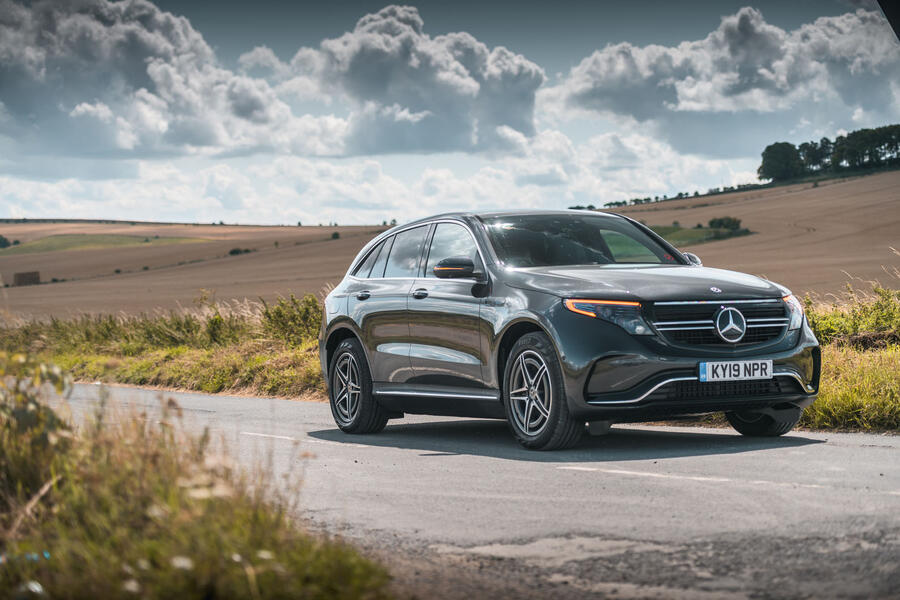
Right now, it’s wafting serenely around the Oxford bypass as part of a four-car convoy that few will hear coming, but that plenty will notice passing. Not that those onlookers will all have nice things to say about the sight of the Mercedes. Photographer Olgun Kordal had it about right when he described the EQC as looking like a Mercedes-Benz GLC “that has been left in the oven too long”. Shame. The Audi is considerably smarter to my eyes, the Tesla marginally less so, with its bulbous proportions and its slightly incongruous sloping roofline.
But it’s the Jaguar that’s the bedroom wall material. Chucking it in among its direct competition only serves to underline what a stellar job was done on the I-Pace’s design and how much more interesting an object it is to behold than pretty much anything else like it.
Well, can’t sit here and admire it all day. As we peel off west towards Wantage, onto smaller and more testing A- and B-roads, I flag down a colleague and swap into the I-Pace. And how great to be reminded what a treat this car is to drive. As well as feeling a good deal lighter, tauter handling, more immediate and more agile than the EQC, it’s got wonderfully tactile and supremely well-weighted steering. And it rides uncommonly well, with a decent sense of cushioning even on 22in rims, and a present but entirely tolerable amount of road noise. For performance, it’s right up there: the EQC’s torque might allow it to pick up more briskly from roundabout pace, but the Jaguar’s almost as quick from low speed.

Holding up on some local country roads we know well gives a chance to hop into all four cars for back-to-back comparisons of the driving experiences they offer – as well as to take some action photographs. My suspicions about the Audi E-tron prove correct: it weighs marginally less than the EQC and yet it feels bigger and heavier because its softer all-corner air suspension and steering are plainly tuned more for comfort and isolation than for handling dynamism. The E-tron is very good at smothering bumps, filtering surface coarseness and making you relax at the wheel. As everyone in the road trip party agrees, though, it’s not nearly as engaging as either the EQC or the I-Pace.
Ask the same party to choose the car they’d drive every day, and without a second thought for where or how, and the result’s equally unanimous: Jaguar, please.

3:32, westbound M4, near Swindon: Our little electric caravan is doing just fine, although since it hasn’t yet been running for a full hundred miles, so it should be. After a few hours, for photos and a bite of lunch, we’re on our way west, taking in our first few motorway miles of the trip and homing in on our final destination for the day: the Alveston House Hotel just north of Bristol.
My first few miles of the trip in the Tesla have just been followed by another few miles in the Audi – and you couldn’t have picked a pair of more different electric operators if you tried. The Model X looks like the rational buy of the group in many ways: biggest battery, best rapid-charging access and room for as many as seven people if you want or need it.
But many of the details of its day-to-day luxury driving experience aren’t quite up to the level of those of its gathered competitors. Sure, it’s quick, but it’s firm riding, too, and quite unsettled on a testing road, with plenty of head toss affecting passengers. The ride’s a bit noisy as well as unyielding, while the cabin sealing is only okay and so admits more wind noise than any of the other cars here.

The Tesla’s cabin is one of a few little rattles and squeaks, whereas they are very few in number in the other cars. Its body panels feel relatively tinny and thin, the front doors pinging a bit cheaply as they close. Sure, it’s big – but there’s not actually any more space in the first or second rows than you’ll find in the E-tron.
Would I be happy with all of the above, having paid nearly £90,000 for a car? I’m not at all convinced I would.
And yet, if I was buying into an ultra-quiet, super-comfortable, low-effort vision of future-proofed family mobility and I wasn’t bothered about driver appeal, I could easily imagine being happy in the Audi. That there isn’t a better luxury car here than the E-tron is as plain as plain can be. The interior looks understated and ‘normal’ next to the Merc’s, but it’s not short of integrity or tactile lavishness and the driving experience also somehow seems simpler than the EQC’s.

The E-tron can be efficient, too. Along with the EQC, it’s one of two cars here that offer you the option to adjust your battery regeneration settings manually via several paddle-accessed settings as you drive. That turns out to be an important means of allowing a driver to be more engaged with, and feel more in control of, what’s happening at the car’s axles than he’d otherwise be. Moreover, if you dial the regen back to nothing, you’ll find that this supremely aerodynamic, low-friction, two-and-a-half-tonne Audi will coast for what seems like miles when running downhill at and around the national speed limit – and, predictably but sure enough, running efficiency benefits by a great deal as you do so.
After nipping over the M48 bridge for another photo, we round off day one in the car park of our hotel and compare trip computers. Of all the cars’ stats, it’s the Jaguar’s that stands out the most – not least for having such an advantage on kerb weight. It’s also very cleverly packaged. Surely, it ought to do much better for battery range – and on smaller wheels, it probably would have. Digital instruments and layout give the EQC a technical feel Audi’s design and material choice brim feel-good factor bit of variance between all four cars in the total distance covered because some took slightly different routes and some did more photos than others.

And the car that has done the best for cruising range, with the biggest cumulative total of miles covered and left in reserve? Model X (although it’s only shaded the next best, the Audi, by 11.5 miles). The one that’s done worst? The Jaguar (see map below).
Wednesday, 10:03am Gloucester Services, northbound M5: Co-driver and occasional Autocar contributor Matt Joy is calling today a ‘cold start’ test for our four cars, which sounds about right. The hotel we stayed in last night didn’t have any charging facilities for EVs, although the prices weren’t bad and neither was the lasagne.
Upshot: the worst-off car in our band had less than 25 miles of indicated available cruising range when we all slammed doors and departed for Milton Keynes at precisely 9.15am.
I’m back in the Mercedes, and I’ve also been lucky. By 9.40am, I’d made it to Gloucester services, bidden and guided very clearly and dependably by the car’s navigation system, and I found a 50kW Ecotricity DC rapid charger that was online and available. An hour and a quarter later, with 42kWh of power and just under 100 miles of range taken on for the price of exactly £12.69, I would be on my way to our final destination with range to spare.

The fortunes of my plucky roadtripping cohorts prove better – and quite a lot worse. Having been directed first by the navigation system in the Audi to a rapid charger that had yet to be installed, and then to another that wasn’t working, Joy arrives at Gloucester services in the E-tron about 45 minutes after me, needing to use the same ‘pump’. His problem? That I’ll still be on it for at least another half an hour; and also that a certain bright orange I-Pace, driven by Autocar picture editor and sketch specialist Ben Summerell-Youde, has already bagsied the next go.
According to charger locator zap-map.com, there are twice as many public rapid-charging stations in the UK today as there were even as recently as 2016 – almost 4500 at the last published count. And yet here we are, queued up for what might be the only working rapid charger in striking distance as if it were the only fuelling station for 1000 miles – but we still need 20 times longer to fill our tanks than a regular petrol pump. Is this the future? Doesn’t feel like it much right now.

Before leaving, I ensure Ben’s enjoying better success in getting the Jaguar to charge than he managed down the road at Michaelwood services (where the car refused to ‘initialise’) and, satisfied that he is, I get on my way. Not sure if that’s smugness or schadenfreude I can feel, or if it’s just the heated seats – but I’m certainly glad to be out of the rain. (Note to the guys at Ecotricity: a weather shelter over your chargers wouldn’t be such a bad idea.)
1:08pm Milton Keynes Coachway: Made it. On any other day and in almost any other car, covering 110 miles in just under four hours would make me feel pretty hard done to. Not today. You can usually average better than 30mph on the M25 in rush hour in any car you like – but to do it across the Cotswolds in an EV, having started the journey at a big disadvantage with a nearly flat battery (as almost any EV owner so rarely would), is better going than I feared I’d make.
And, to prove the point, both the Jaguar and the Audi have made something more akin to the rate of progress I feared I might make: the I-Pace partly because it proved troublesome in refusing to rapid-charge twice for every successful attempt, and the E-tron only because of bad luck and a moment of madness from the navigation system. After another rapid charge on the A40 (preceded by another couple of electronic false starts), the Jaguar eventually returns to our road trip origin at 2.50pm. The Audi is dead last, 10 minutes later.

In terms of foolproof, reliable ease of use and point-to-point ground-covering pace, nothing compares with the Tesla, which was delivered back to Milton Keynes at 12.33pm. At the firm’s Supercharger site at Michaelwood services, it took on 140 miles of range in less than half an hour, charging three times as quickly as the EQC managed.
There are now 55 Tesla Supercharger sites across the UK where you can charge at that speed, and nearly 300 ‘pumps’ available between them. Knowing that much – and how flakey the non-proprietary parts of the UK charging network have proven to be over these past 24 hours – I’d have to think long and hard about choosing any electric car apart from a Tesla right now if I was someone who would likely be depending on public charging on a daily basis.

Victory to the Model X, then? Not quite. The truth is the Tesla would be a deserving enough winner here if only the car was as good as the charging back-up for it undoubtedly is. If, on the other hand, I knew there’d be good charging facilities both at home and at work, and perhaps a second car for longer weekend trips, I’d choose the Jaguar in a heartbeat. If this were any other Autocar group test, a car of such clear dynamic superiority would absolutely walk it.
The Audi deserves honourable mention – and it feels harsh making it come last overall, but it doesn’t quite have the range of abilities of the car I’m handing victory to, and the truth is I’d pick any one of its rivals ahead of it, for very different reasons. But for getting closest to the I-Pace for driver engagement, as well as closest to the Audi for rolling comfort and luxurious ambience – and for making the best of the charging hardware available to it on the testing journey home – the EQC is our winner.
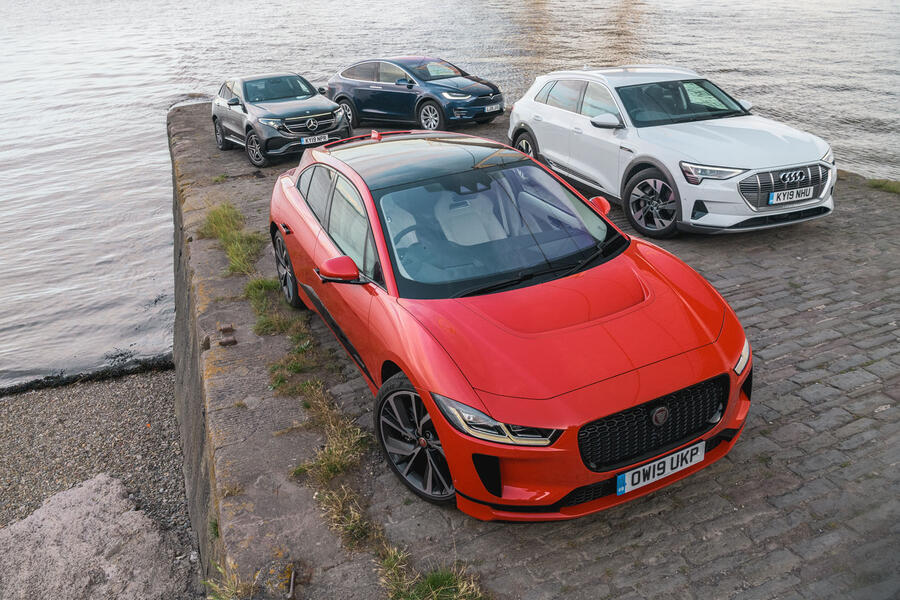
Drivable, roomy, rangey enough and interesting to interact with, the EQC never put a foot wrong on our little electric convoy road trip. And, as we’ve learned, of all the things you want your electric car to do in 2019, ‘just to work’ might be the most important of all.
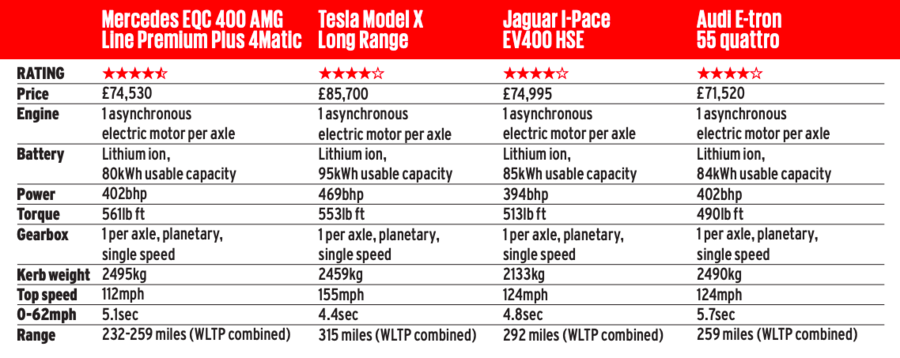
How we charged them
Matt Joy: The Audi’s nav confidently told me we’d make the 20-odd miles from our overnight venue to an Ecotricity charger just outside Gloucester, before cruising the final 90 miles back to Milton Keynes. Unfortunately, that charger doesn’t yet exist, which neatly highlights the biggest problem. The E-tron offers a driving experience as easy – if not easier – than the equivalent combustion-engined car, but with the charging network still demanding a spin of the roulette wheel, it’s not as stress-free as it should be. The Tesla isn’t the best car here but it comfortably has the best charging network, and until that changes, it’s the one I’d rather live with.
Ben Summerell-Youde: Everybody thought the I-Pace was miles better than the other three to drive, but after that return journey, I’d never be able to justify paying £75k to own one. I thought I’d just been unlucky and was trying to recharge at broken chargers to begin with – but since the car “failed to initialise” at least once for every successful charge, and flatly refused to charge at all once or twice, I assume there must have been an electronic glitch with the car itself. Since it’s our long-term test car, here’s hoping Mr Cropley, its keeper, can get it sorted so nobody else gets caught in the rain with no power.
Simon Davis: In the Model X, it was tricky to quash the schadenfreude upon hearing about Ben and Matt J’s charging woes on the drive back to Milton Keynes. More than anything, the Tesla’s fantastic Supercharger network was the most impressive thing about the Model X. The ease of use and rate of charge are simply fantastic. The car itself is a bit of a let-down, though. The ride is far less sophisticated than I thought it would be and the amount of road roar isn’t really acceptable in a luxury car at this price point. I didn’t drive the EQC, but if I had to pick one of the three that I did, the Audi’s serene cabin and comfort-orientated chassis would probably swing it for me.


This article was originally published on 14 September 2019. We're revisiting some of Autocar's most popular features to provide engaging content in these challenging times.
Read more
The electric cars with the best real-world range​
BMW iNext: high-tech electric SUV seen with less disguise











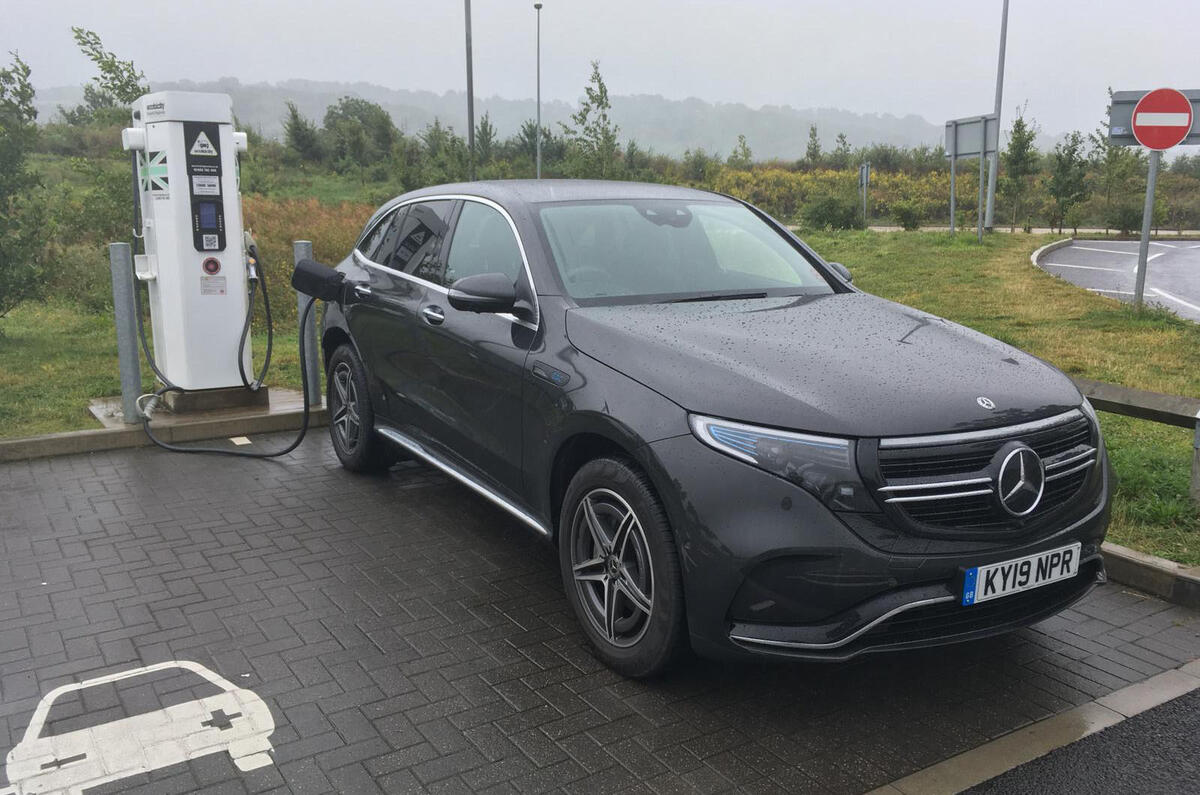
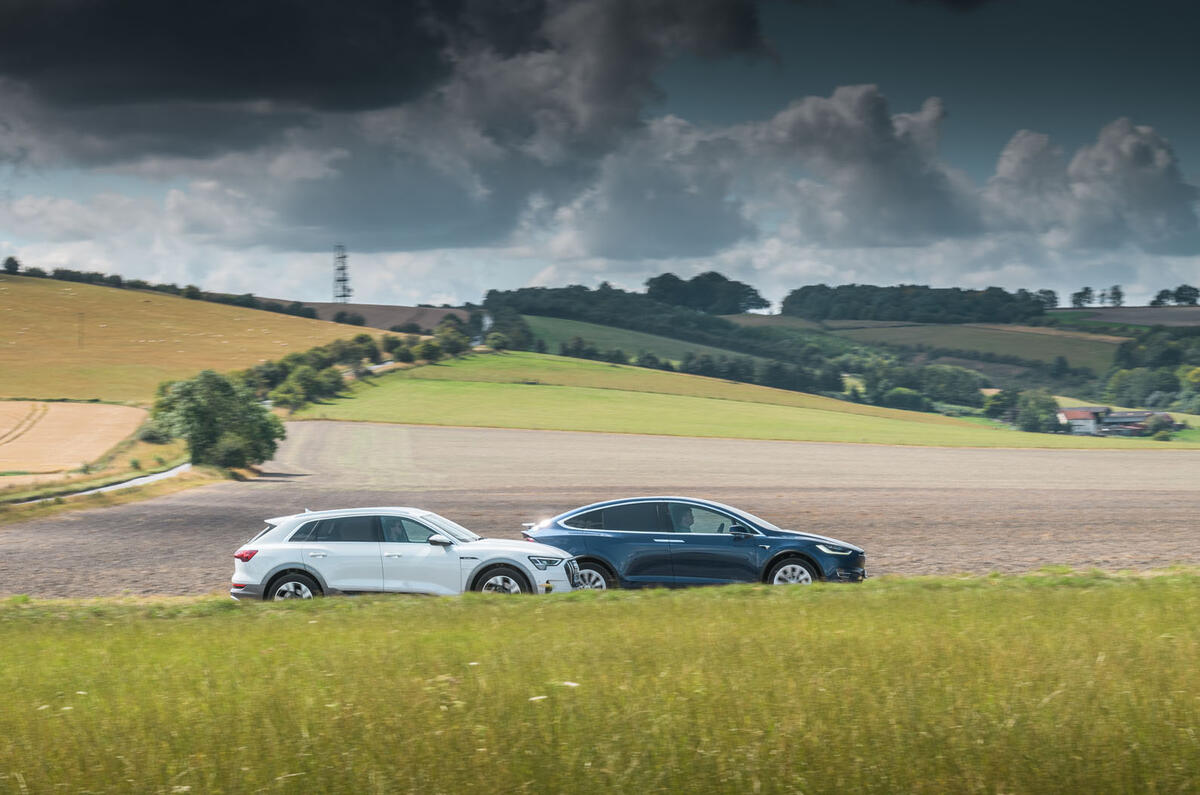











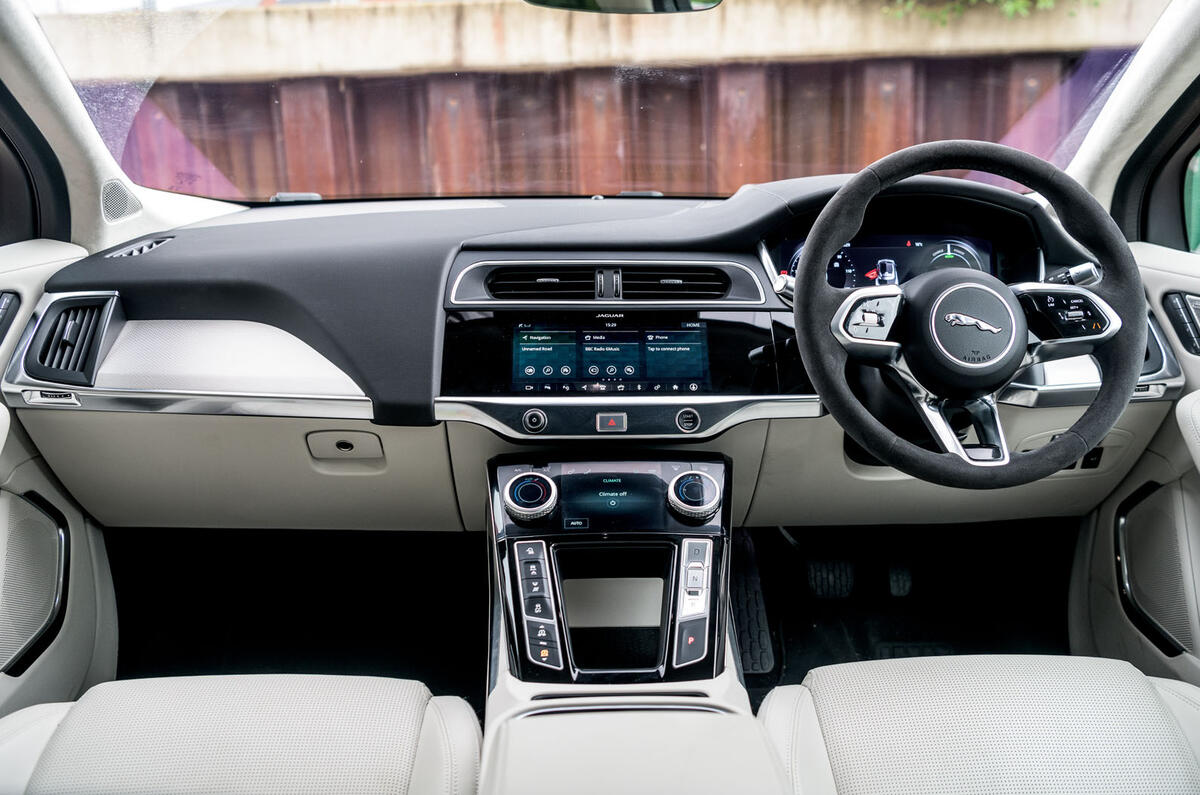










































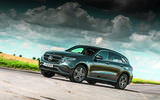











Join the debate
Add your comment
Chargers
Why would you wait in line for the charger at Gloucester services? There are about a dozen rapid chargers in the Gloucester area.
Grate motors , id have each
Battery exchange
NIO has decided to go for battery exchange which Tesla decided to abandon.
If we dont get solid state batteries in the near future then I believe the Chinese system will ultimately prove to be correct especially for Europe. I know it failed in Isreal but electric cars were viewed with sceptisism. Forget about buying cars They are a depreciating liability. Rent a car with an exchangeable battery and then you dont have to worry especially if a group like the AA can do a roadside exchange. The cars are basically good (I have tested a Tesla) BUT the charging infrastructure is nothing short of pathetic
I wonder if DYSON has seen sense because the big players dont seem to
sachael wrote:
Battery exchange is a terrible idea, which is why Tesla abandoned it.
Firstly, the design and integration of the battery is a key part of a company's competitive advantage, allowing swapping means all cars have to be the same size, weight and performance. It is much easier to get everyone to agree what a plug looks like.
Secondly, it is totally pointless, most people don't make that many long journeys beyond the range of a long range electric car hence why Tesla only needs around one supercharger per 200 cars.
Thirdly, charging up an electric car takes, 30 seconds, 15 to plug in and 15 to take it out. You don't have to go to a special place to do it, and you don't have to stand next to it while it charges. Most charging takes place at home while you do something else.
Over the course of the lifetime of the car you might actually spend less time refuelling an electric car.
Fourthly, a charging point is a really tiny bit of infrastructure you can fit to your house a battery swapper is a large piece of robotics and you have store plenty of batteries at the charge site
Fifthly nobody who matters is doing it
Sixthly renting a pool of batteries is more expensive than owning particulary when you factor in the cost of spares, stations, finance. See cost of hire car vs cost of regular car.
Most of the comments on this forum are basically the same as people back in 2008 who were saying that they don't like Iphones,
In 10 years you won't be able to get a new ICE car and you won't want to anyway.